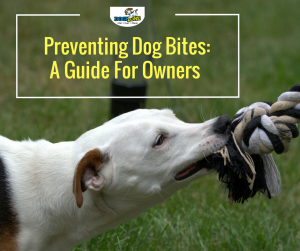Preventing Dog Bites: A Guide For Owners

In most states and localities, controlling a dog of any breed or type is the responsibility of the owner. While there are some exceptions, legal liability always rests with the aggressive dog’s owner. The most common exceptions are if the dog is guarding or protecting and on or her own property or if the individual that was injured provoked the dog.
It is estimated by the CDC (Centers for Disease Control) that there are about 4.7 million dog bite cases a year across the United States. Of this number, approximately 800,000 people receive medical attention, and about half of these will be serious injuries. About 1.8% of these cases will result in hospitalization, and there are about 30 cases of death by dog bites each year. Most of these tragic fatalities involve young children, toddlers, and infants or the elderly.
In most cases, serious injuries from dog bites occur with the very large dogs or with multiple dogs. When dogs are in packs, they are more likely to engage in attack types of behavior, which makes keeping your dog secured and under control all the more important.
Prevention Essentials
However, the size of the dog and the chances of the dog biting are not related. There are just as many toy dogs that show the same high levels of aggression as the breeds listed as “dangerous dogs.” The only difference is that a bite from a Chihuahua or a mixed breed toy or small dog is much less likely to cause the same level of injury as a bite from a German Shepard Dog, Rottweiler or a Pitbull.
Stopping a dog from biting all comes down to training, socialization and knowing your dog. As a dog owner, the following strategies can be very effective in reducing the risk of a bite.
- Routine training – dogs that are routinely worked with for obedience and other types of training tend to be calmer and more relaxed in the presence of their owner. They can also be more easily reassured and trust their “human” to not put them in a threatening situation.
- Early socialization – the earlier and more often a dog is socialized with other animals and with people the less likely the dog will be to become frightened or territorial in a particular situation. Through routine socialization and interaction with others in controlled settings, the dog becomes more confident and comfortable.
- Recognizing anxiety – dog owners need to recognize the signs their pet is becoming anxious, frightened or aggressive. Learn to read your dog’s body language and overall behavior and remove the dog before the situation escalates to the point where the dog bites.
- Use a muzzle when necessary – there are some very humane types of halters and muzzles that can be used for the dog when out on a walk or when training. It is better to be overcautious until you are sure the dog is safe rather than risking the possibility of a bite.
Remember, any breed or type of dog can bite under specific considerations. Knowing your dog and keeping them out of those potential problem environments can go a long way in preventing the risk of a bite.
